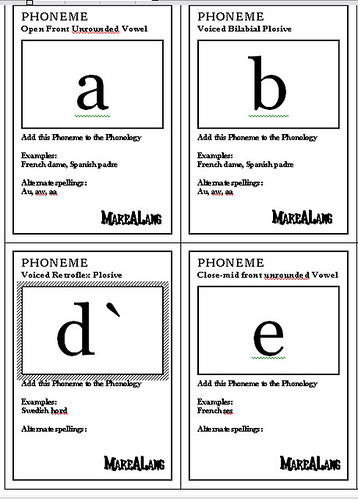After the 2nd LCC, there were two large steps that helped my proto-language for Fauleethik fall into place. The first was I began working on a conlang card game. The Glossotechnia game made my mind race. What could make language experimentation more accessible to your friends and family than a card game? Heck, what could make it more accessible to ME? I knew I needed to wrap my head around linguistic concepts better in order to experiment more and get the results I wanted. Plus, I might get some friends and family involved in my secret vice. Plus, I had an additional idea: what if this could be an easier way to codify and explain your conlang to others? Instead of having to write out a lengthy description with phonology, morphology, syntax, grammer, etc., what if you could just give a code or list of card numbers or something and they can have an almost instant picture of what your conlang is? All these ideas really got me excited to work on this.
Now, a language is a fairly complex piece of work, and the amount and depth of data involved can be extensive. Even a large numbers of cards would probably fall short of being able to COMPLETELY describe and explain a deep and full conlang. But, the flavor/charisma/general characteristics should be able to be expressed, IMHO. This is the premise I started with.

As for the game, here's the basic rules: at the beginning of each game, players are given a sentence (or maybe more than one, for a longer or harder game) to translate. Each turn, each player draws and plays some cards, makes a word from the current pool of phonemes, the goal being to come up with enough words and rules to be able to translate one's sentence; the first one who translates their sentence wins!
Cards played are adding phonemes, restricting the number or class of phonemes, merging phonemes, morphemes, coining inflections, restricting meanings or broadening meanings of words, and it goes on and on. There are cards that restrict your opponant's action on his next turn. Here's a sample of some phoneme cards so far. I'm not done but hope to have some time during the holiday season to finish all these cards up!
Now, a language is a fairly complex piece of work, and the amount and depth of data involved can be extensive. Even a large numbers of cards would probably fall short of being able to COMPLETELY describe and explain a deep and full conlang. But, the flavor/charisma/general characteristics should be able to be expressed, IMHO. This is the premise I started with.

As for the game, here's the basic rules: at the beginning of each game, players are given a sentence (or maybe more than one, for a longer or harder game) to translate. Each turn, each player draws and plays some cards, makes a word from the current pool of phonemes, the goal being to come up with enough words and rules to be able to translate one's sentence; the first one who translates their sentence wins!
Cards played are adding phonemes, restricting the number or class of phonemes, merging phonemes, morphemes, coining inflections, restricting meanings or broadening meanings of words, and it goes on and on. There are cards that restrict your opponant's action on his next turn. Here's a sample of some phoneme cards so far. I'm not done but hope to have some time during the holiday season to finish all these cards up!
Comments
- Baalak Nalzar-aung.
Ich habe einige relevante Informationen, die Sie unten überprüfen können
stargames registrierung
Secret Hitler Game